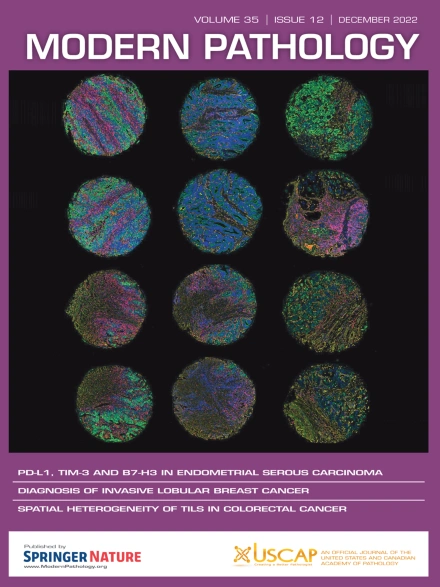乳腺纤维上皮病变的分类及其对进一步治疗的意义。
IF 7.1
1区 医学
Q1 PATHOLOGY
引用次数: 0
摘要
乳腺纤维上皮病变(FELs)构成了一组异质性的双相肿瘤,具有不同的形态和行为。FELs的分类主要基于一系列诊断标准,且瘤内异质性并不罕见。因此,在组织材料有限的核心针活检(CNB)中报告fel可能具有挑战性,因为并非所有特征都可以用于评估。典型纤维腺瘤和典型叶状瘤的区别通常是直接的。然而,细胞纤维腺瘤、形态异质性的良性叶状瘤和肌样错构瘤在组织学上可以重叠。分叶状肿瘤的准确分级对CNB也具有挑战性,并具有重要的管理意义。在这篇文章中,我们提供了概述,并提出了一种实用的方法来报告CNB的fes,特别是对于具有重叠特征的病变。使用英国/欧洲FELs“B”分类的指南,以及各种病变的免费文本描述,也被提出,以帮助进一步的管理决策。本文章由计算机程序翻译,如有差异,请以英文原文为准。
Classification of Fibroepithelial Lesions of the Breast in Core Needle Biopsy With Implications for Further Management
Fibroepithelial lesions (FELs) of the breast represent a diverse group of biphasic tumors with varying morphologies and clinical behavior. The classification of FELs is mainly based on a constellation of diagnostic criteria, and intralesional heterogeneity is not uncommon. Therefore, reporting FELs in a core needle biopsy (CNB) with limited tissue material can be challenging as not all the features may be represented for assessment. Differentiating a classic fibroadenoma from a well-sampled phyllodes tumor (PT) is generally straightforward. However, cellular fibroadenoma, morphologically heterogeneous benign PT, and myoid hamartoma can overlap histologically. Accurate grading of PT is also challenging on CNB and carries significant management implications. In this article, we provide an overview and propose a pragmatic approach to reporting FELs on CNB, particularly for lesions with overlapping features. Guidance using the UK/European “B” classification of FELs alongside descriptive reporting of the various lesions, is also presented to aid in management decisions.
求助全文
通过发布文献求助,成功后即可免费获取论文全文。
去求助
来源期刊

Modern Pathology
医学-病理学
CiteScore
14.30
自引率
2.70%
发文量
174
审稿时长
18 days
期刊介绍:
Modern Pathology, an international journal under the ownership of The United States & Canadian Academy of Pathology (USCAP), serves as an authoritative platform for publishing top-tier clinical and translational research studies in pathology.
Original manuscripts are the primary focus of Modern Pathology, complemented by impactful editorials, reviews, and practice guidelines covering all facets of precision diagnostics in human pathology. The journal's scope includes advancements in molecular diagnostics and genomic classifications of diseases, breakthroughs in immune-oncology, computational science, applied bioinformatics, and digital pathology.
 求助内容:
求助内容: 应助结果提醒方式:
应助结果提醒方式:


